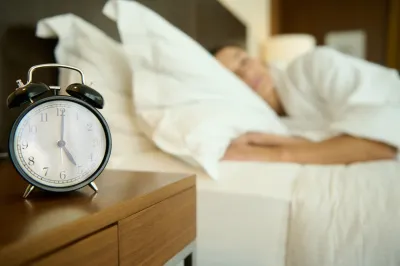Understanding Chronotypes: How Your Body Clock Affects Sleep
Sleepme Editorial Team • Apr 17, 2025

Key Takeaways
- Biological Clock: Your chronotype is your body’s natural schedule for sleeping, waking, and performing at your best—early bird or night owl, it’s built in.
- Three Types: Meet the Sunrise, Daylight, and Nightsky chronotypes. Each one thrives at different times of day—and understanding yours can help you sync with your peak energy hours.
- Sleep Strategy: Knowing your chronotype can help you adjust your sleep and daily routines for deeper sleep, sharper focus, and better mood.
- Personal Optimization: Whether you want to train smarter, work better, or just stop hitting snooze, aligning with your chronotype is a game changer.
Have you ever thought, why is my performance so much better in the early morning than at night? What makes me able to get out of bed without an alarm clock, but my partner cannot wake up without hitting the snooze button four times?
And why am I exhausted at 9:00 PM, yet they are completely full of energy?
It’s simple. Chronotype. Everyone has one, most don’t know what theirs is, and most don’t realize its significant impact on day-to-day life.
What is a Chronotype
Think of your chronotype as your body’s internal operating system—preprogrammed to tell you when to sleep, wake up, eat, think clearly, and even when you’re most creative or cranky. It’s not just about whether you’re a morning person or a night owl. It’s deeper than that.
We all know someone who’s up at 5 AM, crushing workouts before sunrise, but tapping out by 9 PM. And then there’s the night owl who’s at peak productivity when everyone else is asleep and sees noon as an early morning.
That’s your chronotype at work. It’s your biological preference for when you function best—wired into your DNA.
Gender differences in chronotypes can also play a significant role, influencing sleep patterns, personality traits, and overall health outcomes. Understanding how gender interacts with biological rhythms and behavior is crucial for optimizing daily routines and health.
But here’s the kicker: chronotypes go beyond just a consistent sleep schedules. They’re part of your circadian rhythm and influence everything from your metabolism and immune response to your core body temperature and creativity levels.
In short, your chronotype is the master key to understanding your daily rhythm, and optimizing it could be the unlock to better sleep, sharper focus, and a more productive you.
The Science Behind Chronotypes
Chronotypes are determined by a complex interplay of genetic and environmental factors that influence our internal biological clock. At the heart of this system is the master clock, located in the suprachiasmatic nucleus (SCN) of the brain.
This master clock regulates our circadian rhythms, which are the natural, internal processes that follow a roughly 24-hour cycle and respond to light and darkness. These rhythms help synchronize our bodily processes with the day-night cycle, affecting everything from our sleep-wake cycle to our appetite and body temperature.
Research has identified several genes, including the PER3 gene, that play a crucial role in determining our chronotype. Variations in these genes can affect the timing of our sleep-wake cycle, making some people naturally inclined to wake up early and others to stay up late. This genetic predisposition is why some of us are morning people, while others are night owls.
Light exposure also plays a significant role in regulating our circadian rhythms. Morning light exposure helps reset our biological clock, making us feel more alert and awake. In contrast, exposure to light in the evening can suppress the production of melatonin, the hormone that signals our body it’s time to sleep, making it harder to fall asleep.
This is why maintaining a consistent sleep schedule and managing light exposure are important for aligning our sleep patterns with our natural rhythms. Understanding the science behind chronotypes can help us better appreciate the importance of working with our natural rhythms.
By doing so, we can improve our sleep quality, boost productivity, and enhance our overall health.
Enhance Comfort with Cooling Technology
Early bird or night owl, dial in your perfect sleep temp with the Chilipad Dock Pro or Cube. With a range of 55–115º, you’ll sleep deeper and wake up recharged.
What is My Chronotype: The Three Different Chronotypes
While there are different philosophies and opinions around chronotypes, conceptually, the idea is the same no matter what the names of the chronotypes are. Your chronotype is the inherent timeline you should follow for sleeping (and other activities like eating and exercising).
Let’s get into the nitty-gritty. Our three chronotypes. The first two should be fairly obvious, but the last might come as a surprise!
Sunrise
These sleepers go to bed earlier and wake up earlier. They are your typical morning people or early birds. People who are true “Sunrise” chronotypes feel their best earlier in the day, with their energy levels lagging and dropping in the early evening.

Those whose chronotypes are classified as Sunrise, on average, tend to sleep more than others. Sunrise types are most productive in the early hours and tend to feel a natural dip by late afternoon. Bedtime usually rolls around earlier too, often between 8 and 9 p.m., with wake-ups as early as 4 or 5 a.m.
Morning types, are often more productive during the morning hours and have various health benefits linked to their early rising habits.
Daylight
These sleepers are early bird/night owl hybrids that have flexibility. The most difficult thing about being a Daylight is that people with this chronotype tend to have trouble finding a sleep schedule that works best for them. Understanding sleep cycles can help individuals with the Daylight chronotype optimize their sleep schedule by tailoring it to their unique needs, thereby improving sleep quality and maintaining consistency.

Having a Daylight Chronotype isn’t always easy, but on a positive note; Daylights are usually highly productive later in the day.
This chronotype thrives with consistency. Keep your sleep-wake rhythm steady, soak in some morning light, and avoid screens at night to keep your internal clock on point. Sleep usually kicks in around 10 p.m., with waking up around 6 or 7 a.m.
Nightsky
These sleepers go to bed later (and don’t necessarily wake up later). They tend to be the total opposite of the Sunrise chronotypes and makeup approximately 15% of the population. Those who are the Nightsky chronotype tend to sleep a lot less than their Sunrise counterparts. [1]

For these sleepers, they tend to feel the effects of “social-jet lag.” The less our day-to-day schedules are in sync with our natural sleeping patterns and rhythms, the more stress our bodies and minds feel. This is social-jet lag in a nutshell. Due to societal formation and its tendency to follow an earlier schedule, Nightsky are often exhausted and not sleeping as long as they need to.
The best part about knowing your chronotype is that we can help you improve your sleep based on this knowledge. That way, you can easily follow your body clock’s schedule, allowing you to sleep deeper and better and wake rested. This is social-jet lag in a nutshell. Due to societal formation and its tendency to follow an earlier schedule, Nightsky are often exhausted and not sleeping as long as they need to.
Nightsky types are natural night owls. They tend to feel groggy in the mornings, hit their productivity stride in the evening, and often fall asleep well past midnight—think 1 to 3 a.m. Wake-ups usually happen late, making early morning meetings feel like jet lag in real-time.
Takeaway
These three chronotypes are obviously a generalization of characteristics that one might fall into based on their innate inclinations for sleep and wake. There are spectrums within each of these three options.
The best part about knowing your chronotype is that we can help you improve your sleep based on this knowledge. That way, you can easily follow your body clock’s schedule, allowing you to sleep deeper and better and wake rested.
Why Knowing Your Sleep Chronotype Actually Matters
Understanding your chronotype is like unlocking your body’s user manual. It’s not just about when you sleep, it’s about how you function throughout your entire day.
Your chronotype is wired into your 24-hour circadian rhythm (our natural wake/sleep cycle) and influences the ideal times for everything from sleeping and eating to working out and getting focused.
Want to know when your brain is firing on all cylinders? Or when that afternoon slump is most likely to hit? Your chronotype already knows.
When you align your daily routine with your chronotype, life flows more smoothly. Productivity improves. Energy levels feel more stable. Even decisions like when to take your supplements or schedule important meetings can be optimized.
Long story short? Knowing your chronotype helps you stop working against your biology—and start working with it.
Benefits of Knowing Your Chronotype
- Understand when you fall asleep.
- A better understanding of the connection between sleep-wake time and mental health.
- Help keep you on track with your eating habits.
- Aligns your schedule with your natural energy peaks
- Helps you sleep better and wake up refreshed
- Maximizes productivity by timing work with mental sharpness
- Improves mood and reduces burnout
- Makes healthy habits—like eating and exercising—easier to stick to
- Enhances overall well-being by syncing with your body’s internal clock
- Different chronotypes influence personality traits such as conscientiousness and agreeableness, impacting daily functioning and psychological profiles
How Your Chronotype Shapes Your Sleep Schedule
No matter your chronotype—whether you’re an early bird, night owl, or somewhere in the middle—the key to better sleep is maintaining a consistent schedule. Your body thrives on rhythm, and when you miss your ideal sleep window, things can quickly fall out of sync.
Early chronotypes may experience social jetlag when engaging in late evening activities, leading to difficulties during the day when their natural sleep schedule is disrupted.
If you’ve ever caught a second wind late at night, that’s a sign you may have missed your natural time to wind down. When that happens, it can take longer to fall asleep, and you might lose out on the deep, restorative sleep your body needs.
Temperature regulation also plays a big role in your sleep pattern. Your body needs to cool down to enter and stay in deep sleep. A bed cooling system can help manage your core temperature, making it easier to reach and maintain those deeper sleep stages.
By syncing your sleep schedule with your chronotype and supporting it with the right tools, you give your body the conditions it needs to rest, recover, and perform at its best.
Can You Change Your Chronotype?
The short answer is no. Your chronotype is hardwired into your DNA, linked to the PER3 gene, which plays a role in your body’s internal clock and cell regulation. That means you can’t change your chronotype—but it can naturally shift as you age.
For example, most young kids are Sunrise, making them rise and go to sleep early. They wake up with the sun and tire out early in the evening. But as they grow, their sleep patterns evolve, and they gradually settle into the chronotype they’re genetically inclined toward.
Individuals with certain chronotypes, may accumulate sleep debt during the workweek and compensate by sleeping more on weekends. This inconsistent sleep routine can disrupt their circadian rhythms.
The good news is, while you can’t change your chronotype, you can learn to work with it. Here are some practical ways to sync your daily routine with your natural rhythm.
Flexible Work Schedule
If you’re a Nightsky or Daylight chronotype, the standard 8 a.m. grind might clash with your natural rhythm. Instead, aim for a job or role that allows for flexible hours, so you can hit the ground running when your energy is naturally at its highest.
Individuals who work night shifts need to adjust their circadian rhythm to accommodate their unique sleep-wake cycles. Techniques such as bright light exposure and using blackout curtains can improve sleep quality during the day, helping to align work schedules with natural bodily functions.
For example, a Nightsky might thrive with a 12 p.m. to 8 p.m. schedule, hitting peak focus in the late afternoon, while a Daylight might do their best work starting around 9:30 a.m., once they’ve had time to fully wake up and settle in.
When your workday aligns with your chronotype, you’re not just working, you’re optimizing.
Take a Short Nap
If you work remotely, napping during your lunch break can be a simple yet powerful way to recharge. A [quick power nap—about 10 to 20 minutes—can boost alertness and focus. If you have a little more time, a 30 to 60-minute nap may help with memory and creative thinking.
Even stepping away from your screen for a short rest can reduce stress and reset your mental energy. A midday nap isn’t laziness, it’s strategic recovery that can make your afternoon far more productive.
Routines are Key
No matter your chronotype, consistency is the secret weapon for better sleep and sharper focus. Going to bed and waking up at the same time every day—even on weekends—helps regulate your internal clock and keeps your energy steady.
Think of it like setting your body’s firmware update on a recurring schedule. For example, if you're a Daylight chronotype, sticking to a 10:30 p.m. bedtime and a 7 a.m. wake-up can help lock in your natural rhythm and make mornings feel way less painful.
Bottom Line: Routines train your brain and body to show up at their best, every single day.
Tip: Adopting a bedtime routine that matches your chronotype helps you get consistent, high-quality sleep—even if your sleep schedule doesn’t fit the traditional mold. When your habits align with your natural rhythm, you're not just sleeping more, you're sleeping smarter.
Final Thoughts: Tune Into Your Chronotype and Sleep Smarter
Your chronotype isn’t just a fun personality label—it’s a science-backed blueprint for optimizing your sleep, energy, focus, and overall well-being. Whether you’re a Sunrise, Daylight, or Nightsky, knowing how your body naturally operates can help you build smarter habits that actually work for you, not against you.
Understanding sleep wake patterns can inform personal habits that improve overall sleep quality and health, highlighting the relationship between chronotype, daily alertness, and various factors affecting lifestyle.
The real power lies in working with your internal clock. From fine-tuning your daily routine to optimizing your sleep environment with tools like a bed cooling system, small changes can make a big impact. You’ll sleep deeper, enjoy higher-quality sleep, wake up sharper, and move through your day with more energy, focus, and clarity.
Bottom line? The better you understand your chronotype, the better you can support your body and mind—one well-timed night of sleep at a time.
Frequently asked questions
Can I Change My Chronotype?
Not exactly. Despite the inherent nature of your chronotype, it can be modified through specific behaviors and environmental adjustments. Your chronotype is largely biological, but you can work with it by adjusting your routine and sleep habits to better match your natural rhythms.
What Are the Common Chronotypes?
They are also known as:
- Bear: Follows the sun. Most alert during daylight. Sleepy when it’s dark.
- Lion: Early riser, early crusher of goals, early to bed.
- Wolf: Night owl energy. Creative and alert late in the day.
- Dolphin: Light sleeper, sporadic rhythms. Always seeking better sleep structure.
Which is the Most Popular Chronotype?
The most common chronotype, the Sunrise, is characterized by a sleep-wake cycle that is strongly anchored to the natural cues of sunrise and sunset, making daylight their primary active period and the night sky their signal for rest.
Resources
[1] What is My Chronotype? (Chronotypes Defined). (2017, July 30) View Resource









